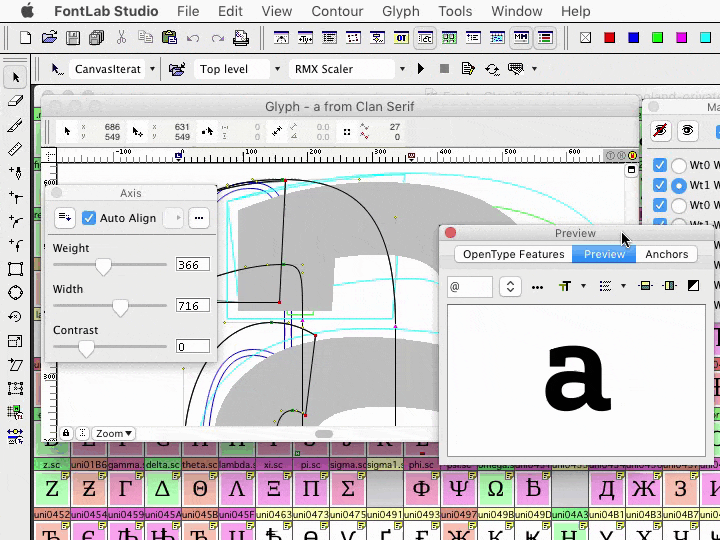

In the early 2000s, an ex-Netscape programmer George Williams started developing FontForge (originally under a different name), the first open source GUI font editor. In the late 1990s, Just van Rossum wrote fontTools/TTX, a pure-Python open source parsing and manipulation toolkit for OpenType fonts.
#Fontlab mac mac os#
In 2001, FontLab 4.0 added support for Python, and a few years later the RoboFog team created a Python library called RoboFab which allowed running scripts written for RoboFog to be run within FontLab.Īll these apps were commercial and ran mostly on Mac OS or Windows. The app was acquired by Microsoft and extended by Beat Stamm to become VTT, the visual TrueType hinting tool, which is available for free. Among other things, he created TypeMan, an app for TrueType hinting. One of the engineers who originally created the TrueType font format at Apple, and the inventor of the TrueType hinting language, Sampo Kaasila, started his own company Type Solutions, later acquired by Bitstream and ultimately by Monotype. It developed the FontLab font editor and a few other tools (TypeTool, ScanFont, TransType).Īlso in the early 1990s, Peter van Blokland, Erik van Blokland and Just van Rossum created RoboFog, an extended version of Fontographer 3.5 that included support for Python, a scripting language created by Just’s brother Guido van Rossum.
#Fontlab mac software#
Portions of the software ended up as part of Flash, Freehand was abandoned but Fontographer was sold to FontLab.Īround 1990, FontLab was formed as a U.S.-Russian collaboration. The development of Fontographer stalled for a decade. Altsys later extended Fontographer into Freehand, a full-blown vector graphic editor, then was acquired by Macromedia and later by Adobe. In 1985, Altsys, a Texas-based company, developed Fontographer, the first Macintosh app that allowed drawing with Bézier curves, and the first PostScript Type 1 font editor. There some very capable apps in the package though the user interface of some may be a bit dated. The successor of URW, URW++ together with Dutch Type Library continued development of Ikarus based-tools under the DTL FontMaster brand. Peter van Blokland ported it to the Mac as Ikarus M. In 1975, the Hamburg-based company URW published Ikarus, the first computerized system for designing outline-based fonts. Click on the section called "Studio 5" or "fontlabVI" or whatever prefs you want to remove and choose Edit > Delete (or press the Del key).Adam Twardoch offered a brief history of type tools on the fonttools mailing list in September 2017, which with permission is added to this book and can be freely edited and expanded. In the left part of Regedit window, open HKEY_CURRENT_USER\Software\Fontlab section.ģ. Run the utility for editing system registry regedit.exe.Ģ. To wipe preferences out from the registry:ġ. On Windows, preferences reside in the system registry. Otherwise macOS will restore the cached preferences. Thus, after you delete (or change) the plist file you need to run the above command in the Terminal window. The service doing the caching is called "cfprefsd". Run Terminal, put the following command after the prompt and press Return:Įxplanation of step 4: macOS caches preferences (since 10.9). For example, FontLab VI keeps preferences in .Ĥ. plist extension starting with "com.fontlab". But you can reach it using the Finder's Go menu with the Alt key pressed.Ģ. Quit the application (FontLab VI, Fontlab Studio, TypeTool, etc.).ġ. To remove the preferences file correctly:Ġ. dialogs, bookmarks in the Font window, custom brushes etc.Īll Fontlab apps keep their preferences in the user's ~/Library/Preferences folder. Removing the preferences file will reset menus, the list of recent files, custom workspaces, loaded files for phrases and pairs, opened panels, view settings, recent settings in the Export Font, Open Font etc. If that doesn’t help, you can also do it manually by removing the preferences file. You get that by clicking on the button with the three horizontal lines: First, you can use the "hamburger" menu in the Preferences dialog to reset all settings to their defaults. If FontLab behaves strangely, sometimes resetting the app preferences may help. Modified on: Fri, 11 Jan, 2019 at 9:48 PM Solution home Other apps FontLab VI How can I reset preferences/remove the preferences file


 0 kommentar(er)
0 kommentar(er)
